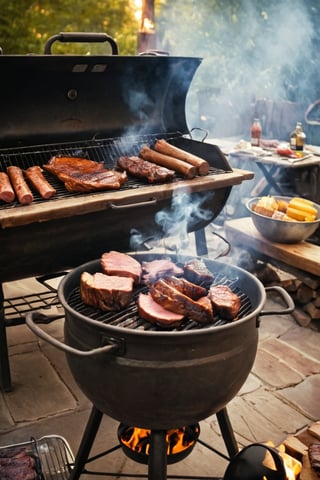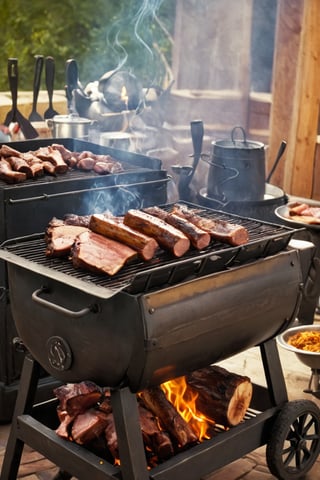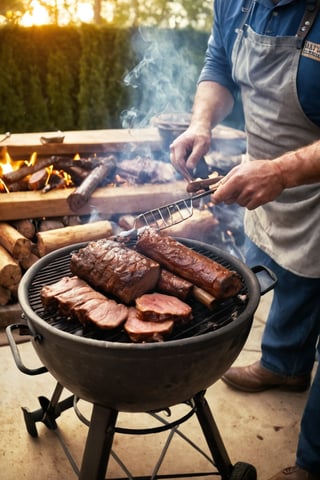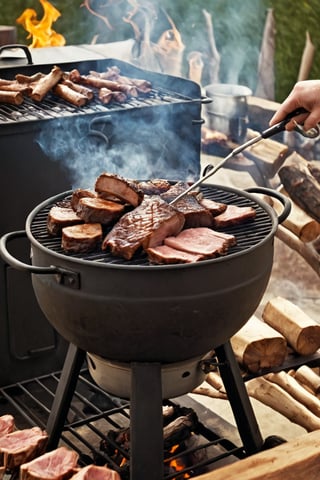LaRecalcada
Published:
Create a richly detailed and atmospheric illustration that captures the essence of a Southern BBQ smoker in action. The scene should highlight the traditional smoker setup, the process of preparing and smoking meats, and the smoky, savory ambiance of Southern BBQ. Set the scene in a rustic outdoor setting, such as a backyard or a classic BBQ pit area, surrounded by elements that evoke the heart of Southern BBQ culture: 1. **Setting Up the Smoker:** Begin with a scene of the BBQ smoker setup. Show a large, traditional smoker or BBQ pit made from steel or brick, with a firebox on the side. The smoker should be well-seasoned, with a patina that reflects years of use. Include stacks of split wood logs, such as hickory, oak, or mesquite, ready to be used for smoking. The background should feature a rustic outdoor area, possibly with a wooden fence, a few trees, and a shed or barn nearby. 2. **Igniting the Fire:** Illustrate the process of starting the fire in the smoker’s firebox. Show a cook or pitmaster lighting the wood or charcoal, with flames beginning to catch and smoke starting to rise. Capture the glow of the fire, the initial bursts of smoke, and the tools used to manage the fire, like a poker or tongs. 3. **Preparing the Meats:** Depict a table next to the smoker where various cuts of meat are being prepared for smoking. Show a selection of meats typical of Southern BBQ, such as brisket, pork shoulders, ribs, and sausages. Highlight the process of seasoning the meats with dry rubs or marinades, emphasizing the rich, textured surface of the spice blends being applied. Include bowls of spices, jars of rubs, and brushes for basting. 4. **Loading the Smoker:** Visualize the cook placing the seasoned meats into the smoker. Show the smoker's lid or doors open, revealing the grill racks or hooks inside where the meats are being arranged. Capture the process of carefully positioning the meats for even smoking, with a focus on the brisket or ribs. Include the gentle smoke wafting out as the lid is opened and closed. 5. **Smoking and Tending the Fire:** Illustrate the smoker in action, with thick, aromatic smoke billowing out from the vents or chimney. Show the cook monitoring the temperature using a gauge on the smoker or an external thermometer. Highlight the tools used to manage the fire and smoke flow, such as dampers and vents. Include a close-up of the firebox, with logs burning steadily and embers glowing. 6. **Basting and Turning:** Depict the process of basting and turning the meats during smoking. Show the cook opening the smoker to apply a mop sauce or glaze, using a brush or mop to coat the meats, creating a glossy, caramelized surface. Emphasize the rich, golden-brown crust forming on the meats and the aroma of the basting sauce mixing with the smoke. 7. **Resting and Carving:** Transition to a scene of the cooked meats being removed from the smoker and allowed to rest. Show the meats resting on a wooden board, juices settling, and the crust developed to perfection. Next, illustrate the cook slicing into the brisket or pulling apart the pork shoulder, revealing the tender, juicy interior and the distinctive smoke ring. 8. **Atmosphere and Surroundings:** Conclude with a backdrop that reflects the Southern BBQ atmosphere. Include details like wooden picnic tables set up nearby, guests enjoying the smoky aroma, and rustic decorations like string lights or metal signs. Capture the warm, inviting feel of the scene, with the sun setting or a cool breeze blowing, enhancing the communal and festive spirit of the BBQ. Use warm, earthy tones and detailed textures to bring each stage to life, from the flickering fire and smoky meats to the rustic charm of the setting. Each stage should be clearly labeled to guide the viewer through the traditional process of using a Southern BBQ smoker. This prompt should vividly capture the detailed, smoky, and atmospheric experience of preparing meats in a Southern BBQ smoker, highlighting the meticulous steps and the rich cultural context.
Comments







